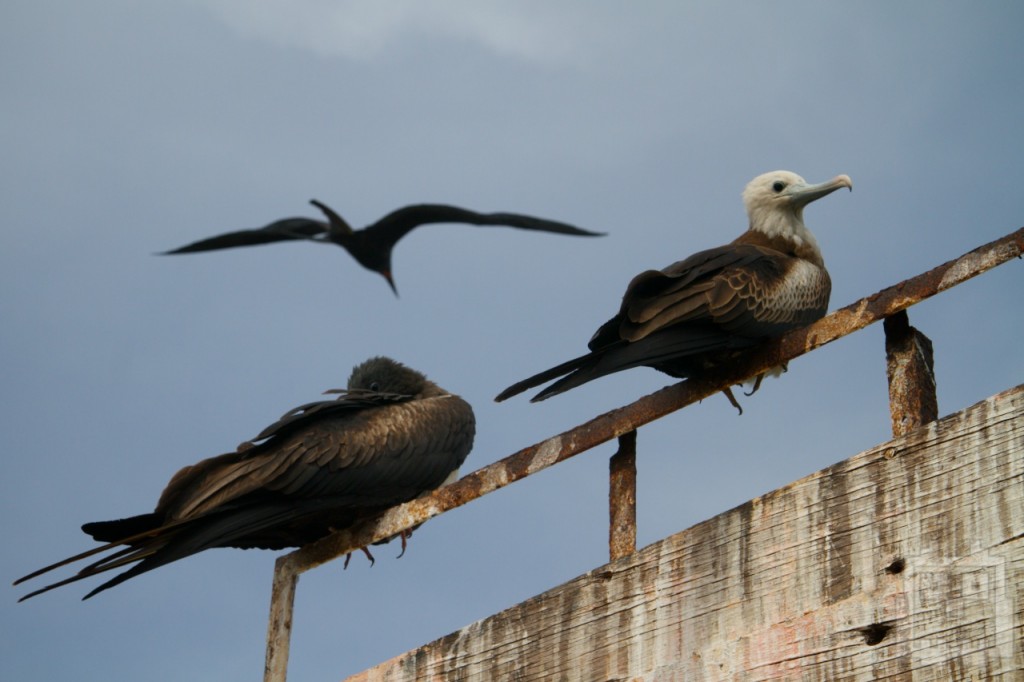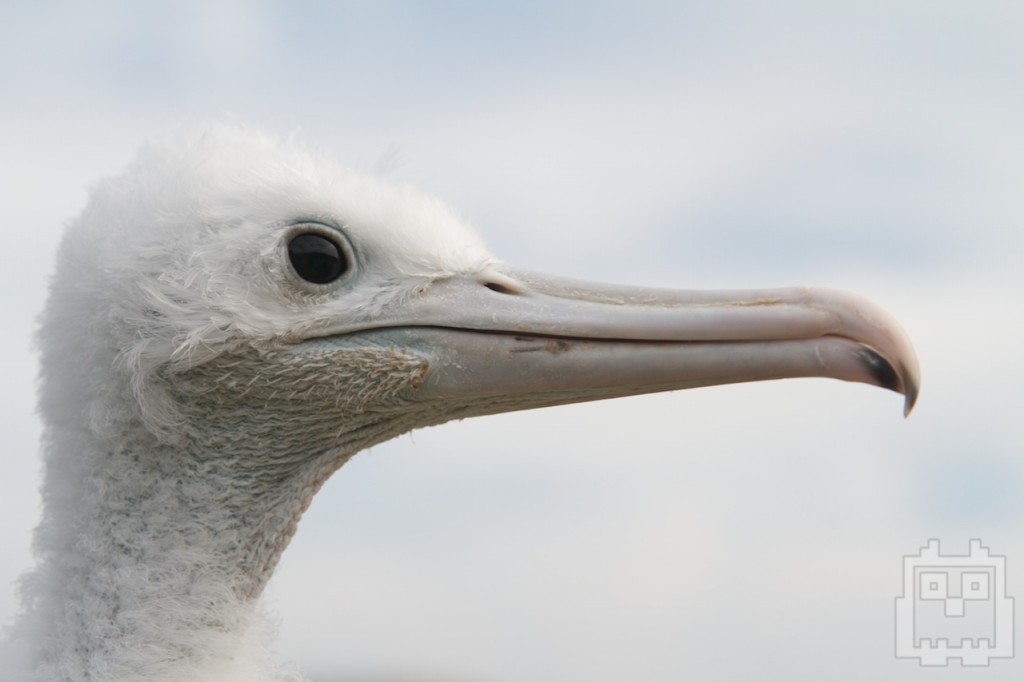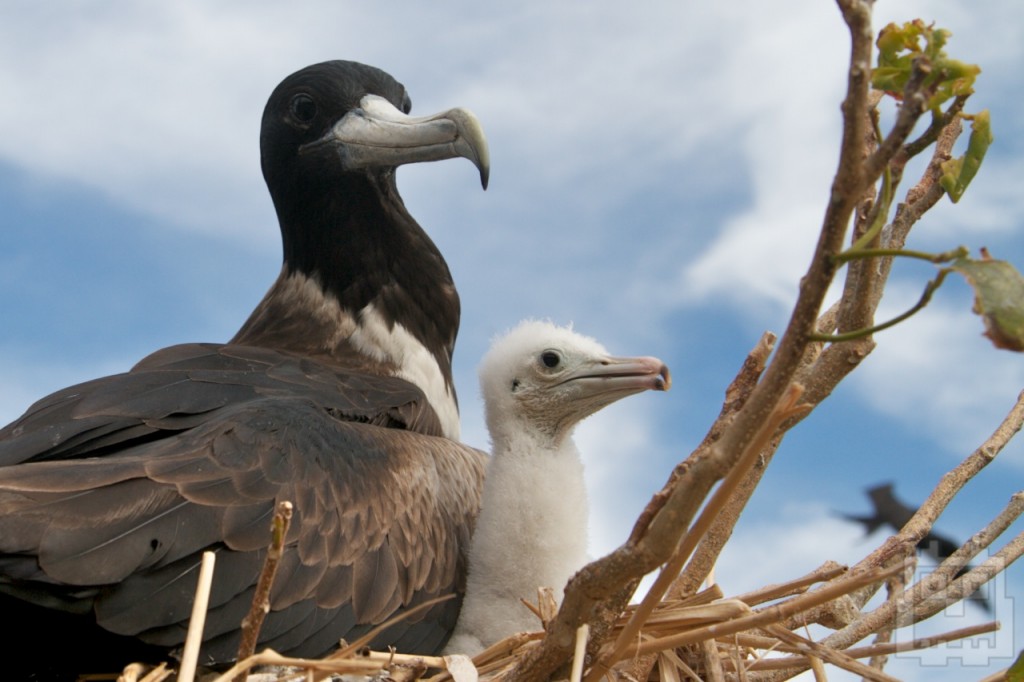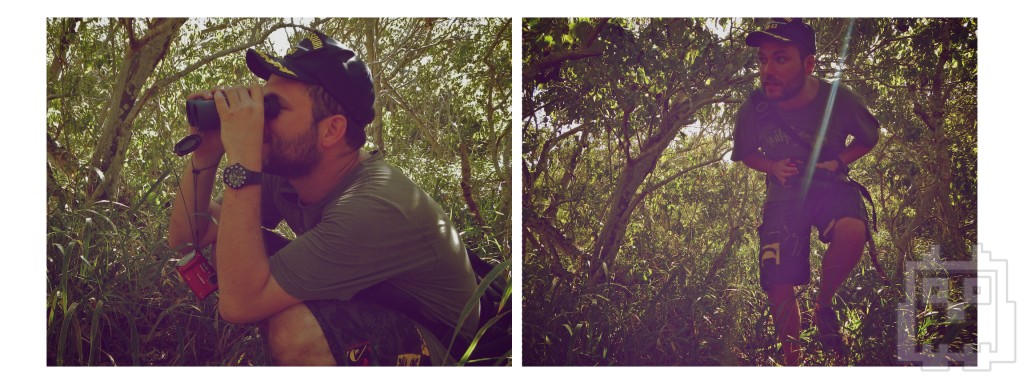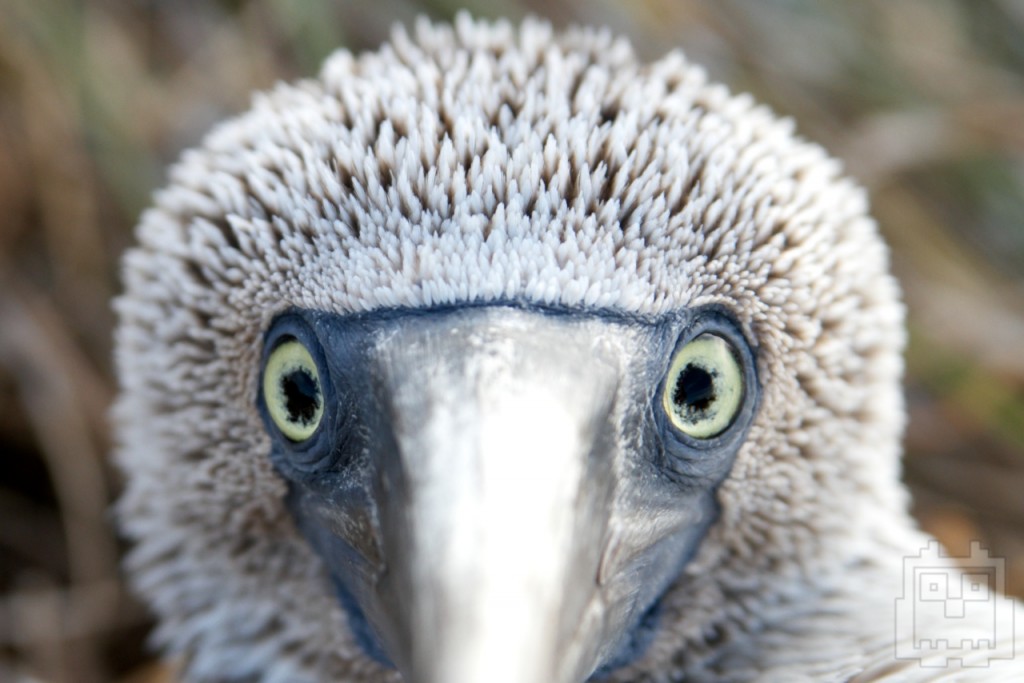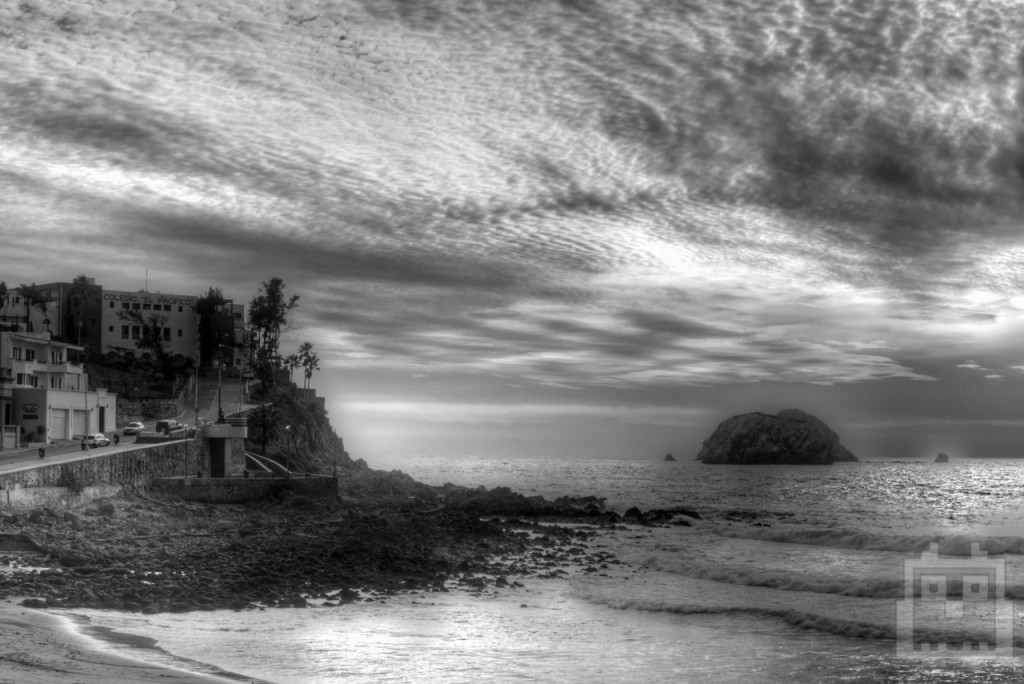Sail Panache
Strutting across the PacificBlog
When I say Boobies, I Mean the Bird.

Mazatlan. I was tired, Panache was anchored next to a sewage treatment facility, and the one restaurant I ate at didn't impress me. Maybe I was judging Mazatlan a little too early, but it was over. James and I already pulled the anchor and were heading for Isla Isabela - the self-proclaimed Galapagos of Mexico. The island spans only about a mile in either direction and is located 93 miles south of Mazatlan. Just a short overnight sail to an island paradise.
Tour boats were traveling past us, while Panache motored out of the harbor. The boatload of tourists were waving eagerly to us, but I don’t think they realized the name of their vessel was The Titanic. The wind was blowing from the north and set us up perfectly for a downwind sail. We were finally experiencing sunny weather and a completely relaxing sail - the complete antithesis of what we experienced coming over from La Paz. The boat was sailing itself, and I had a cold margarita in one hand and a good book in the other.
Our repose was only briefly suspended by a jumping bat ray who was convinced by someone he could fly. With every new attempt - and there were many - his little flippers were waving with an ever increasing eagerness. I almost expected the bat ray, roughly the size of a large cutting board, to zip off into space. This must be the equivalent to a human swimming in water.
While we were making good time, it wasn't good enough to get there before dark. I swiveled the radar screen into the cockpit and turned it on... I pressed the on button to turn it on... Jesus! I PRESSED THE ON BUTTON TO TURN THE FUCKING RADAR ON!! But nothing happened. The radar must have experienced some kind of failure during the storm a couple of days earlier. A wave did crash into the boat and take out the inverter, and now the radar was added to the growing list of casualties aboard Panache. Aside from this generally sucking in a loss of gear kind of way, it was going to make a night landing at Isabela difficult. The guide book suggests not to enter the anchorage at night, and from the pictures I can see why. Jagged rocks surround the anchorage like teeth, and being such a small island, swell affects everything. Oh, and they call the anchorage an anchor eater, because apparently its a really rocky spot where anchors tend to get stuck. While I am milling this over in my head James snaps me back to reality with a music request. Pink Floyd, Dark Side of the Moon.
Great choice, and surprisingly this would only be the second time I would listen to the album while sailing Panache. It’s not that I don’t like the album or the artist; I love them both. It’s just one of those albums that requires a special surrounding to fully appreciated, otherwise you’re just not doing the music justice. The first time was coming down the Baja coast, 80 miles off shore with not a lumen of ambient light to disrupt the flocks of twinkling stars above. The infinity of the night sky was a perfect backdrop from the album, and this night was equally clear.
Before ‘On the Run’ can even start a pack of four dolphins join the boat. Music is a good way to attract sea mammals to your boat because sound waves can travel so far underwater, and a boat hull is a good way to transmit those waves. Apparently James and I were not the only ones who liked Pink Floyd. The night was so dark and the bioluminescence was so strong that you could see the dolphins in the water perfectly. Everywhere they swam, a bright green ribbon of light would follow them. It was like watching the dolphin version of TRON. My previous experience with dolphins is that they are excited to see you, but lose interest quickly. These dolphins broke that expectation and swam with Panache for the better part of thirty minutes. With the boat being steered by the windvane, James and I could clamber all over the boat to watch the synchronized swimming show the dolphins were orchestrating to Pink Floyd’s Dark Side of the Moon.
I spent most of the show hanging from the bow of the boat dangling my feet in the water as the dolphins criss-crossed between the port and starboard wake of the boat. Not to take a word away from Apple’s marketing team, but the experience was Magical. When the song ‘Brain Damage’ came on, the dolphins started smacking their tails against the water. Less than a minute later, the pack of four jetted off and were gone. Maybe tail slaps is some kind of dolphin code to change songs. I had no idea dolphins were so picky about their music preferences. Still dazed I looked up and saw the light beacon for Isla Isabela in the distance. Game time.
Luckily two other boats were in the anchorage and this made guiding Panache to safety rather easy. Radar or not, we made it work. James and I sat on deck sipping hot chocolate and discussing what we thought the Island would be like. In the veil of night we could only guess, but the sounds that echoed from shore sounded like something from a Michel Crichton novel; Congo or Jurassic Park. Sleep took hold despite the rolling motion, and morning coffee washed the groggy feeling that only comes from going to bed late and waking up early. We loaded the dinghy with the day’s provisions and headed for shore.
On the way in we noticed that one of the boats in the anchorage had left. So we were sharing the island with only one other boat. Seems silly to think about that on such a small island, but I relished the fact that I would be forced to discover everything on the island myself, not from some guide book, or another all too helpful cruiser. The main beach was lined with shacks the fisherman use as a layover for selling their catch on the mainland. The night before we watched many fishing boats working late into the night. Who knows what they were fishing for, but being this far off shore it must be worth it.
James and I dragged the dinghy far onto the beach and immediately confronted the stench of bird droppings. It was unavoidable, and should have been expected. Magnificent frigatebirds made a black cloud above the island.
While no giant tortoises exist on Isla Isabela, they do have iguanas that occasionally take a dip in the ocean. One such lizard was waiting for us by our dinghy. A simple nod to thank us for visiting and the reptile stuffed himself back into one of the many holes the beach had to offer. We took a long gaze at the map outlining the island for visitors. The upkeep for such a remote place was obviously not on the list of priorities for the Mexican Government, but no worries, the broke down feel gave it a sense of adventure.
We started off west on the island and ran directly into a complex, the one building on the island. This was supposedly where the ranger for the island camped. No tours, and not even a ranger to find, James and I ended up wandering around the abandon building for the next thirty minutes. It was obvious someone had been staying there. The building was monstrous. Someone with vision definitely took it upon themselves to create an attraction, but like many projects in Mexico, this one probably ran out of money and was left to disintegrate back into the earth. Huge iguanas were warming themselves on the slabs of broken concrete that surrounded the complex, and you could even walk onto the second floor to look down upon frigatebird nests.
Babies and eggs were in every nest. It was hatching season. My inner Audubon wanted to get as close as possible for a photo, but after scaring a mother from her nest entirely, I decided to keep my distance.
James and I left the frigatebird paradise and migrated to the booby side. The island has three types of boobies; brown, red, and the most famous the blue-footed booby. We had yet to see one of the blue varieties, but were in a swath of land dominated by the brown type. They make a tired squonk noise that’s akin to an old bike horn being squeezed beyond its potential. If this wasn't enough, the trail James and I were blazing was a beaks reach from all these momma birds protecting their nests. Deafen the intruders with a honk and poke their feet out with the sharp beak was the preferred brown booby technique for destroying human intruders.
Since all the nesting brown boobies didn't want anything to do with us, we decided to check out the most distinguishable feature of the island (from a Google Earth perspective), a huge crater lake right in the center of the island. The interior of Isabela is covered with huge trees that offer lots of headroom. The crater lake wasn't as impressive as Google Earth made it out to be, but the trail snaked all the way to the other side of the island, so we continued our exploration. Walking up the other side of the crater we were met by another frigatebird who must have been going through a serious molting process. It was sitting right in the middle of the trail and was staring us down. When we approached the bird, he turned and flapped down the path another ten feet and turned to glare at us again. We did this for several minutes, let the bird be our tour guide, and finally it decided to veer off trail into the woods. For a bird with such a huge wing span, flying beneath trees is a tricky process - not really enough room to get a full flap.
As we continued down the path a new sound stopped us in our tracks. It was a honk, like the brown boobies, but deeper. More angry. James and I looked at each other and knew this must have been the blue-footed booby. James, like I, have never seen a blue-footed booby, and was overwhelmed with excitement. The sound was resonating just off trail. Naturally, we started to crawl commando style under bushes and through the dirt to get a better look. Sure enough, the culprit was a pair of blue boobies. We watched the two for a while and then heard another new sound. A pair of feet walking on the trail. It was a group from the one other boat!
We crawled out from the bushes and chatted for a while, informing them that WE had found a pair of blue footed boobies. They smiled and with a plain face informed us that a whole community of blue footed boobies were several yards down the trail. They were right. James and I were crawling through dirt for a glimpse of a booby, when we could have walked another 20 feet and ran into a pair that was nesting in the middle of the fucking trail. Classic.
On this side of the island, a team of grad students were tagging and studying the blue boobies. We talked with one of the students, I asked her too many questions, and she replied eagerly with a smile. I was personally curious about how the frigatebirds effects the Booby population. Apparently the relationship is parasitic. The Boobies, amazing at fishing, are prone to aerial attacks by the frigatebirds to the point of stealing their catch. Boobies can dive sometimes 10 feet into the water to catch fish. I even watched one attack where the booby dove into the water and rocketed back out with a fish in its beak. Frigatebirds are faster and more agile in the air, and use this to their advantage. Why fish when you can steal from a booby!?
James and I left the students to their studies and sat on the beach to watch the war games play out in front of us. The beach was covered in fine sand with the exception of one ribbon of broken up pieces of reef and shells. When you walked next to this rough ribbon, it would crackle and shells would start rolling down the beach. This was all the little hermit crabs sucking back into their shells for protection, and consequently rolling towards the water. The beach was literally alive. Everything was. Isabela was a paradise after all.
We waited out the rest of the day on the beach, and when a bright sunset started its takeover, we hoofed it back to Panache. Sleep was easy after such a full day. In the morning we sailed off the anchor, and started James’ final leg into La Cruz. The sail was slow but highlighted by a visitor; the scruffiest looking hummingbird on the face of the earth. It sat on the port side of the boat catching its breath for a good 5 hours before it continued its journey.
When we finally entered Banderas Bay I thought I we were lost. Banderas Bay really is that big. From La Paz, James and I had seen good weather, bad weather, and lots of boobies. I can’t think of anything more satisfying.
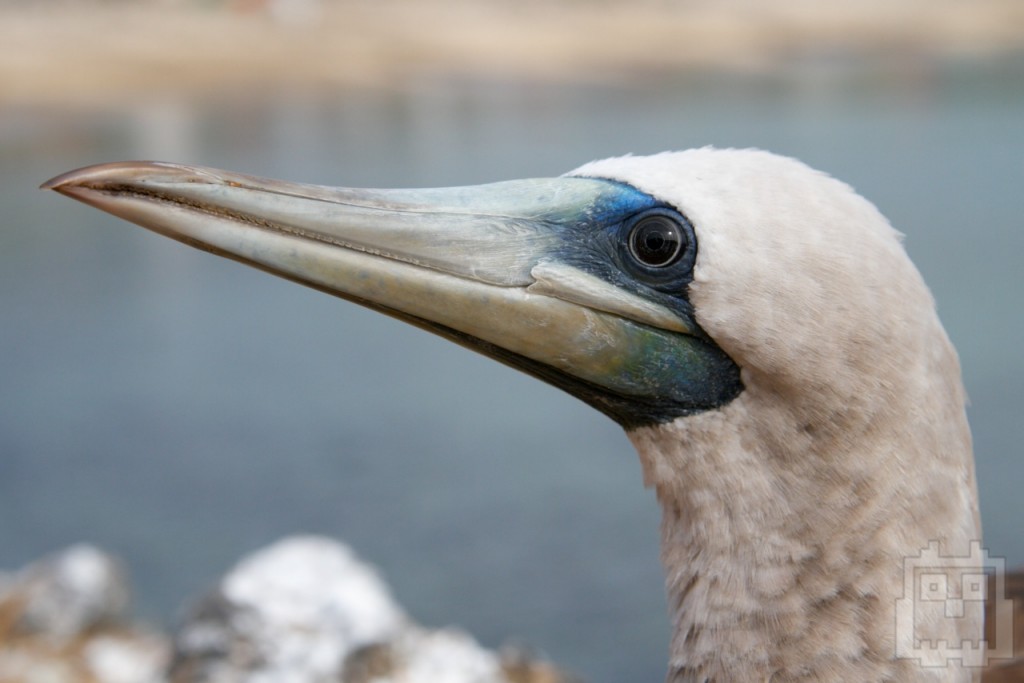





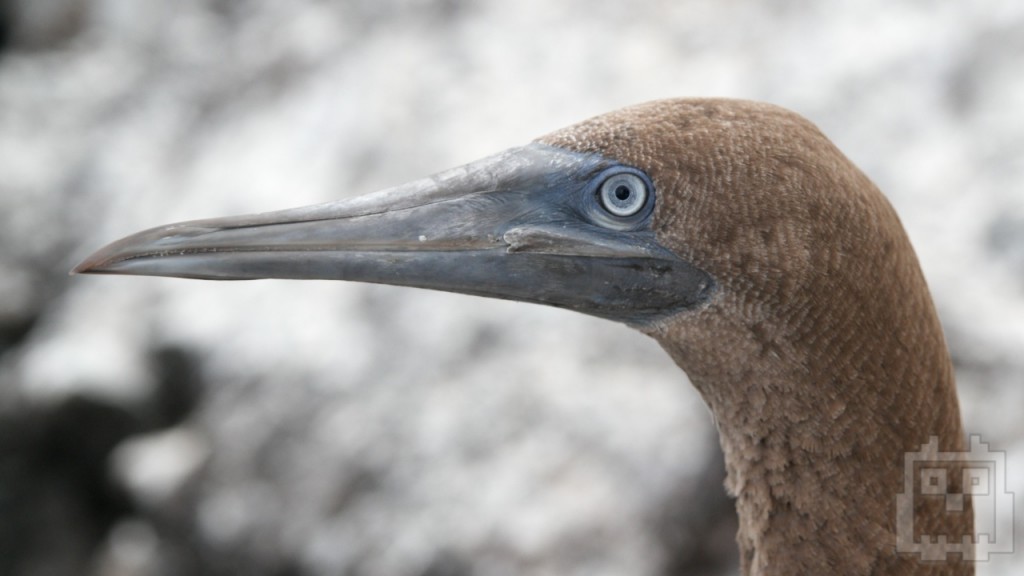

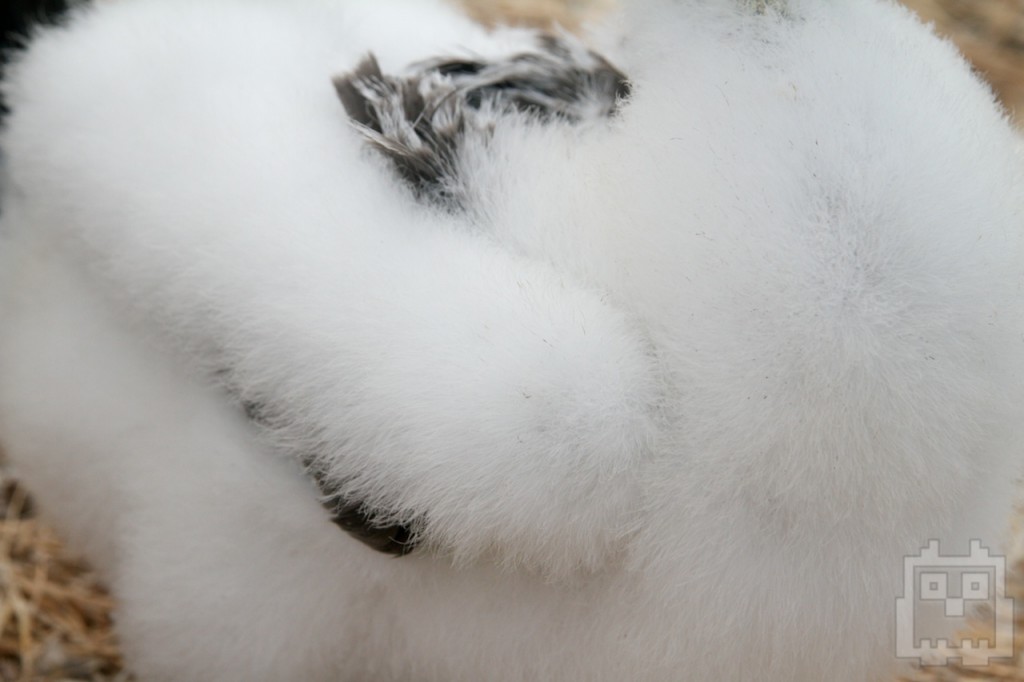
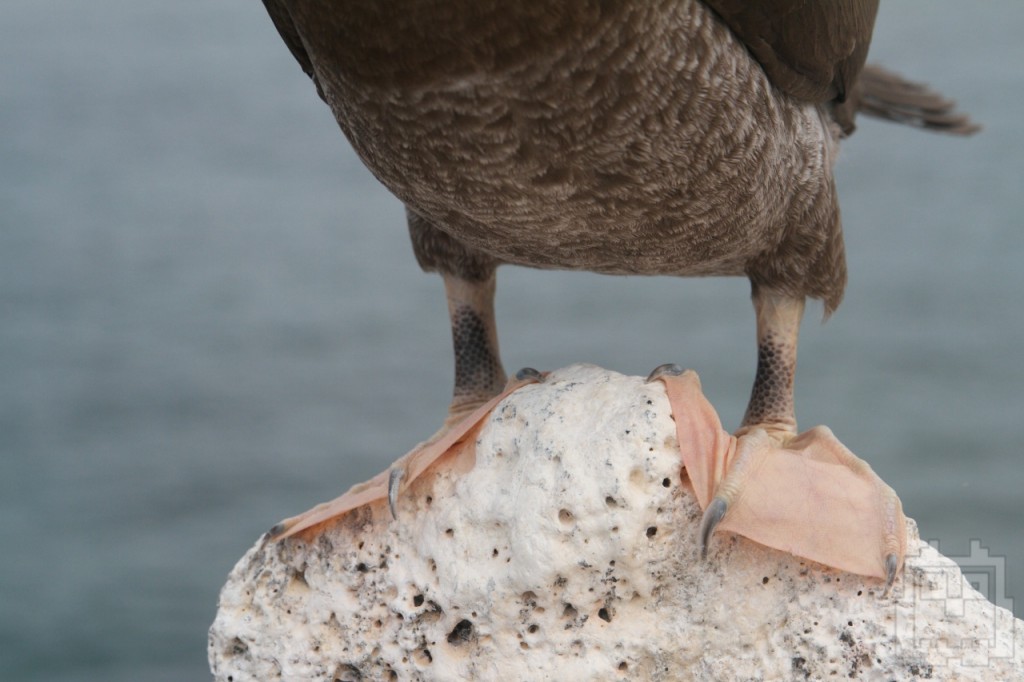



















Storming to Mazatlan
 Making the crossing from La Paz to mainland Mexico isn't exactly demanding, IF you wait for a good weather. Thats a big if. Crossing the street can be demanding with enough wind and rain. The coming weekend presented a glowing weather report, but I had bigger issues besides the barometric pressure. I had no crew. Sure, I could single hand, but I am a social creature, and I couldn't find a Wilson volleyball anywhere to supplement my social tooth.
I was spending much of my time with the boys from Saltbreaker. They all lived in SF bay (as I had), were about the same age as me, and also had the plan of cruising until they had no money. The company was easy and entertaining, and I appreciated the fact that not a single conversation ended with “you are too young to understand.” With four dudes packed on 32 feet of boat, Saltbreaker suggested I borrow crew to make the crossing over to Mazatlan with them, and then buddy boat all the way down the coast. Keep in mind this offer was established a day before they were leaving. This would be a perfect option, but by that point I had a college buddy (James) already signed on as crew. Saltbreaker lobbied hard for me to leave the next day, arguing that they were going to spend Christmas in Barra De Navidad (Christmas bay)! I mean, how perfect is that!? I reluctantly declined, and waited for James to finish law school finals. No worries, we planed to see each other further down south.
Its a funny feeling to suddenly have concrete plans. I really had no serious commitments, and then like some light switch was flipped off in the free world and I had serious obligations to facilitate flight schedules. At a certain time, someone was going to rely on me, and the thought of this was a little overwhelming. There was no room for flexibility. I was now on a schedule other than mother natures, something every sailor should never do. The up side? I had crew.
During my last week in La Paz, I watched a huge system move into the Sea of Cortez. From the GRIB files, it looked like James and I would just barely miss the bad weather. It was going to be close, but I believed we would arrive in Mazatlan for Christmas wearing smiles.
Two days before my departure I opted to buy some used solar panels. I hated running the diesel engine for power. Its noisy, smelly and expensive, but my energy consumption requires me to run it almost every day. Currently, If I wanted to listen to music and leave my anchor light on all night I needed to feed the noise beast. Also, I am no diesel mechanic, so I prefer to keep the wear and tear on such a crucial piece of equipment to a minimum. Solar panels were the obvious solution.
The wiring turned out to cost more than the panels themselves, and the installation turned out to take longer than expected. James landed in Mexico while I was still working on getting everything situated for the trip across. Our early departure turned into a late one. Finishing the solar installation prompted an oil change that prompted a fuel filter change. Now every boat has limited space compared to a house, but the spot where the fuel filter rested was down right perverse. I called Tony, the previous owner, and when I asked him about the fuel filter he just laughed and said “Yeah, I really fucked up when installing it in that spot. Just keep trying to unscrew it, it just takes some time and lots of swearing.” I ended up having to take the whole fuel filter enclosure out of the boat and ask a machine shop to unscrew it with a huge vice!
It was now sunset, and we had been sitting at the Marina de La Paz fuel dock for upwards of 8 hours. Marina security finally came over to ask me why I was still there. A million apologies later, I told them it would never happen again and that we were off to Mazatlan. Ask for forgiveness not permission.
Traveling out of the channel against the current was like climbing up an escalator moving in the opposite direction. Slow going and most embarrassing. When night took over the sky, the current eased and we started a slow beat to San Lorenzo channel. The wind was increasing, and by the time we hit the Channel, Panache was in a consistent 15 knots - good sailing. The sea state started to get a little ugly, and when we reached the end of the channel, 25 knots of wind was not uncommon. I struck the headsail, reefed the main and started an upwind port tack to round the north end of Cerralvo Island. The wind and waves kept getting bigger and bigger. I put the second reef in, but when I started seeing 30 knots on a regular basis I dropped the main all together. We had just started our crossing and the weather was rough. We would not beat the weather after all.
With the noise machine on, Panache was only making 1.5 knots towards Cerralvo Island, and with the wind and waves smashing us in the wrong direction, I was doubtful we would even make it round the point. I was starting to feel nausea from the sea state but we needed to make some moves to get more drive. I put on my harness and clipped into the jack lines, and with the storm jib in hand clumsily inched my way to the bow of the boat. With every swell, the deck would rise and fall four feet. It was ugly. The commotion on deck, plus barf breaks, slowed the process to attach the inner forestay. I am a very functional while sea sick. Once up, the storm jib pulled us at a comfortable 4.5 knots and thankfully leveled out the boat.
At day break we rounded the north point of Cerralvo Island and hopped on a broad reach, 110 degrees towards Mazatlan. James and I would work shifts of three hours on - getting rocked by the waves and wind - and three hours off, trying to sleep while the steal chainplates screamed under the intense pressure of the 30-43 knot gusts. All my foul weather gear was sitting in Oakland, so I used a trash bag and some rain pants James brought along for comfort. We would trade this soggy outfit at the beginning of each shift. You could never get dry, because waves would break over the stern of the boat filling the cockpit with water. This could be avoided if you could preemptively steer dead downwind with the exceptionally huge swells, but after the first day we were so sleep deprived that taking a wave or two or three was inevitable.
At night the wind would wipe water across the sea, lighting up the bioluminescence. The sea looked like it was on fire. Its hard to be impressed by this when you are tired, hungry, and need to look out for waves crashing over the boat. I would look at my watch and it might read 3:00am, and when I though a considerable amount of time passed I would look at my watch again and it would still read 3:00am. I was tired. I was starting to hear things out in the ocean. Sirens from The Odyssey come to mind, seductresses calling sailors to their death. It was torture, and creepy. The sailing was so mentally and physically taxing my hand would be sore by the end of my shift from gripping the tiller so tightly. Physically taxing out of necessity to keep Panache pointed correctly, and mentally taxing out of the fear of broaching Panache or worse.
By day three the wind had tapered off to the low 20s, and the sea state had started to flatten. I set the wind vein, put on my last set of dry clothes and stretched out in the cockpit for a morning nap. Just as I was getting comfortable a wave crushed over the boat turning the cockpit into a pool. Comfort was useless for the remaining miles.
We arrived in Mazatlan on Christmas eve. Stepping on land was a true gift. James and I effectively had forgone sleep for three days and were among the ranks of the walking dead. Internet, food, lots of staring off into space and then back to the boat. We feel asleep around 7pm. James’ return flight to the states had put us in some compromising weather. A mistake I will not make again. We knew what we were getting into, we had the equipment to get through it, but the weather just made for a really uncomfortable (and unforgettable) three days. As crazy as those three days were, I am glad to have the experience. After all, a picture perfect crossing provides very little for bragging rights. Bloated with self confidence, James and I departed Mazatlan for Isla Isabella, The Galapagos of Mexico.
Making the crossing from La Paz to mainland Mexico isn't exactly demanding, IF you wait for a good weather. Thats a big if. Crossing the street can be demanding with enough wind and rain. The coming weekend presented a glowing weather report, but I had bigger issues besides the barometric pressure. I had no crew. Sure, I could single hand, but I am a social creature, and I couldn't find a Wilson volleyball anywhere to supplement my social tooth.
I was spending much of my time with the boys from Saltbreaker. They all lived in SF bay (as I had), were about the same age as me, and also had the plan of cruising until they had no money. The company was easy and entertaining, and I appreciated the fact that not a single conversation ended with “you are too young to understand.” With four dudes packed on 32 feet of boat, Saltbreaker suggested I borrow crew to make the crossing over to Mazatlan with them, and then buddy boat all the way down the coast. Keep in mind this offer was established a day before they were leaving. This would be a perfect option, but by that point I had a college buddy (James) already signed on as crew. Saltbreaker lobbied hard for me to leave the next day, arguing that they were going to spend Christmas in Barra De Navidad (Christmas bay)! I mean, how perfect is that!? I reluctantly declined, and waited for James to finish law school finals. No worries, we planed to see each other further down south.
Its a funny feeling to suddenly have concrete plans. I really had no serious commitments, and then like some light switch was flipped off in the free world and I had serious obligations to facilitate flight schedules. At a certain time, someone was going to rely on me, and the thought of this was a little overwhelming. There was no room for flexibility. I was now on a schedule other than mother natures, something every sailor should never do. The up side? I had crew.
During my last week in La Paz, I watched a huge system move into the Sea of Cortez. From the GRIB files, it looked like James and I would just barely miss the bad weather. It was going to be close, but I believed we would arrive in Mazatlan for Christmas wearing smiles.
Two days before my departure I opted to buy some used solar panels. I hated running the diesel engine for power. Its noisy, smelly and expensive, but my energy consumption requires me to run it almost every day. Currently, If I wanted to listen to music and leave my anchor light on all night I needed to feed the noise beast. Also, I am no diesel mechanic, so I prefer to keep the wear and tear on such a crucial piece of equipment to a minimum. Solar panels were the obvious solution.
The wiring turned out to cost more than the panels themselves, and the installation turned out to take longer than expected. James landed in Mexico while I was still working on getting everything situated for the trip across. Our early departure turned into a late one. Finishing the solar installation prompted an oil change that prompted a fuel filter change. Now every boat has limited space compared to a house, but the spot where the fuel filter rested was down right perverse. I called Tony, the previous owner, and when I asked him about the fuel filter he just laughed and said “Yeah, I really fucked up when installing it in that spot. Just keep trying to unscrew it, it just takes some time and lots of swearing.” I ended up having to take the whole fuel filter enclosure out of the boat and ask a machine shop to unscrew it with a huge vice!
It was now sunset, and we had been sitting at the Marina de La Paz fuel dock for upwards of 8 hours. Marina security finally came over to ask me why I was still there. A million apologies later, I told them it would never happen again and that we were off to Mazatlan. Ask for forgiveness not permission.
Traveling out of the channel against the current was like climbing up an escalator moving in the opposite direction. Slow going and most embarrassing. When night took over the sky, the current eased and we started a slow beat to San Lorenzo channel. The wind was increasing, and by the time we hit the Channel, Panache was in a consistent 15 knots - good sailing. The sea state started to get a little ugly, and when we reached the end of the channel, 25 knots of wind was not uncommon. I struck the headsail, reefed the main and started an upwind port tack to round the north end of Cerralvo Island. The wind and waves kept getting bigger and bigger. I put the second reef in, but when I started seeing 30 knots on a regular basis I dropped the main all together. We had just started our crossing and the weather was rough. We would not beat the weather after all.
With the noise machine on, Panache was only making 1.5 knots towards Cerralvo Island, and with the wind and waves smashing us in the wrong direction, I was doubtful we would even make it round the point. I was starting to feel nausea from the sea state but we needed to make some moves to get more drive. I put on my harness and clipped into the jack lines, and with the storm jib in hand clumsily inched my way to the bow of the boat. With every swell, the deck would rise and fall four feet. It was ugly. The commotion on deck, plus barf breaks, slowed the process to attach the inner forestay. I am a very functional while sea sick. Once up, the storm jib pulled us at a comfortable 4.5 knots and thankfully leveled out the boat.
At day break we rounded the north point of Cerralvo Island and hopped on a broad reach, 110 degrees towards Mazatlan. James and I would work shifts of three hours on - getting rocked by the waves and wind - and three hours off, trying to sleep while the steal chainplates screamed under the intense pressure of the 30-43 knot gusts. All my foul weather gear was sitting in Oakland, so I used a trash bag and some rain pants James brought along for comfort. We would trade this soggy outfit at the beginning of each shift. You could never get dry, because waves would break over the stern of the boat filling the cockpit with water. This could be avoided if you could preemptively steer dead downwind with the exceptionally huge swells, but after the first day we were so sleep deprived that taking a wave or two or three was inevitable.
At night the wind would wipe water across the sea, lighting up the bioluminescence. The sea looked like it was on fire. Its hard to be impressed by this when you are tired, hungry, and need to look out for waves crashing over the boat. I would look at my watch and it might read 3:00am, and when I though a considerable amount of time passed I would look at my watch again and it would still read 3:00am. I was tired. I was starting to hear things out in the ocean. Sirens from The Odyssey come to mind, seductresses calling sailors to their death. It was torture, and creepy. The sailing was so mentally and physically taxing my hand would be sore by the end of my shift from gripping the tiller so tightly. Physically taxing out of necessity to keep Panache pointed correctly, and mentally taxing out of the fear of broaching Panache or worse.
By day three the wind had tapered off to the low 20s, and the sea state had started to flatten. I set the wind vein, put on my last set of dry clothes and stretched out in the cockpit for a morning nap. Just as I was getting comfortable a wave crushed over the boat turning the cockpit into a pool. Comfort was useless for the remaining miles.
We arrived in Mazatlan on Christmas eve. Stepping on land was a true gift. James and I effectively had forgone sleep for three days and were among the ranks of the walking dead. Internet, food, lots of staring off into space and then back to the boat. We feel asleep around 7pm. James’ return flight to the states had put us in some compromising weather. A mistake I will not make again. We knew what we were getting into, we had the equipment to get through it, but the weather just made for a really uncomfortable (and unforgettable) three days. As crazy as those three days were, I am glad to have the experience. After all, a picture perfect crossing provides very little for bragging rights. Bloated with self confidence, James and I departed Mazatlan for Isla Isabella, The Galapagos of Mexico.



